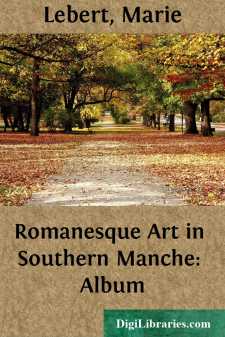Categories
- Antiques & Collectibles 13
- Architecture 36
- Art 48
- Bibles 22
- Biography & Autobiography 813
- Body, Mind & Spirit 142
- Business & Economics 28
- Children's Books 15
- Children's Fiction 12
- Computers 4
- Cooking 94
- Crafts & Hobbies 4
- Drama 346
- Education 46
- Family & Relationships 57
- Fiction 11828
- Games 19
- Gardening 17
- Health & Fitness 34
- History 1377
- House & Home 1
- Humor 147
- Juvenile Fiction 1873
- Juvenile Nonfiction 202
- Language Arts & Disciplines 88
- Law 16
- Literary Collections 686
- Literary Criticism 179
- Mathematics 13
- Medical 41
- Music 40
- Nature 179
- Non-Classifiable 1768
- Performing Arts 7
- Periodicals 1453
- Philosophy 64
- Photography 2
- Poetry 896
- Political Science 203
- Psychology 42
- Reference 154
- Religion 513
- Science 126
- Self-Help 84
- Social Science 81
- Sports & Recreation 34
- Study Aids 3
- Technology & Engineering 59
- Transportation 23
- Travel 463
- True Crime 29
Romanesque Art in Southern Manche: Album
by: Marie Lebert
Description:
Excerpt
001. In this album, there are no monuments described in all touristic guides. On the contrary, these twelve Romanesque churches are little known. They are located in Southern Manche, that is to say in the southern part of the department of Manche, in Normandy, along the coast or in the countryside. These churches were built in the 10th, 11th and 12th century by villagers and parishioners, with local stones—schist and granite—on the medieval roads used by pilgrims to reach Mont Saint-Michel, their final destination after travelling for many months.
[Illustration]
002. Southern Manche. The map of the region. From north to south, these blue spots show the churches of Saint-Martin-le-Vieux, Bréville, Yquelon, Saint-Pair-sur-Mer, Angey, Saint-Jean-le-Thomas, Dragey, Genêts, Saint-Léonard-de-Vains, Saint-Loup and Saint-Quentin-sur-le-Homme, without forgetting the beautiful Romanesque gate in Sartilly. This map was digitized by Georges Cercel.
[Illustration]
003. Southern Manche. An old map of the region. This region has belonged to Cotentin for its northern part and Avranchin for its southern part. The limit between Cotentin and Avranchin is the small river Thar, that flows into the Channel at the south of Granville. In the Middle Ages, this region was rich, with more people living on the coast than inside the land. The economic life was active, with fisheries, salines near Saint-Martin-de-Bréhal, Bréville and Saint-Léonard-de-Vains, pitch sand and kelp used as fertilizers, and a number of intensive cultures. This old map belongs to the collection of the city library in Granville. Photo by Claude Rayon. [Claude-02]
[Illustration]
004. Southern Manche. The deanery of Saint-Pair. The parishes of Saint-Martin-le-Vieux, Bréville, Yquelon and Saint-Pair-sur-Mer were part of the deanery of Saint-Pair, one of the five deaneries of the archidiachoné of Coutances. The archidiachoné of Coutances was one of the four archidiachonés of the diocese of Coutances, the other ones being the archidiachonés of Cotentin, Bauptois and Val-de-Vire. Map by Marie Lebert.
[Illustration]
005. Southern Manche. The deanery of Genêts. The parishes of Angey, Sartilly, Saint-Jean-le-Thomas, Dragey and Genêts were part of the deanery of Genêts and the archidiachoné of Avranches, like the priory of Saint-Léonard-de-Vains. The archidiachoné of Avranches included three other deaneries: the deanery of Avranches, the deanery of Tirepied (that included the parish of Saint-Loup) and the deanery of the Chrétienté (Christendom). The deanery of the Chrétienté included nine parishes around the episcopal town of Avranches, including the parish of Saint-Quentin-sur-le-Homme. Map by Marie Lebert.
[Illustration]
006. Southern Manche. The medieval roads going to Mont Saint-Michel. This region was crossed by several roads used by pilgrims to reach Mont Saint-Michel. At the north of Avranches, we had from west to east the shore road coming from Saint-Pair-sur-Mer, the road coming from Saint-Pair-sur-Mer (with a different route), the road coming from Coutances, the road coming from Saint-Lô, and the road coming from Caen. At the south of Avranches, a medieval road was used by the pilgrims coming from Tinchebray, Condé-sur-Noireau, Falaise or Lisieux to reach Mont Saint-Michel. Map by Marie Lebert.
[Illustration]
007. Southern Manche. Geological map. All these churches were built in granite and schist, which were the local stones. Sedimentary grounds formed by schist rocks surround two large granite grounds, those of Vire and Avranches....


